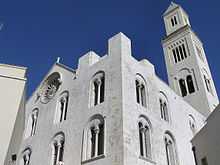Roman Catholic Archdiocese of Bari-Bitonto
| Archdiocese of Bari-Bitonto Archidioecesis Barensis-Bituntinus | |
|---|---|
 Cathedral in Bari | |
| Location | |
| Country | Italy |
| Ecclesiastical province | Bari-Bitonto |
| Statistics | |
| Area | 1,264 km2 (488 sq mi) |
| Population - Total - Catholics |
(as of 2006) 740,900 732,277 (98.8%) |
| Parishes | 125 |
| Information | |
| Denomination | Catholic Church |
| Rite | Roman Rite |
| Established | 4th Century |
| Cathedral | Cattedrale-Basilica di S. Maria |
| Co-cathedral | Concattedrale di Maria SS. Assunta |
| Current leadership | |
| Pope | Francis |
| Archbishop | Francesco Cacucci |
| Website | |
| www.arcidiocesibaribitonto.it | |

The archdiocese of Bari-Bitonto (Latin: Archidioecesis Barensis-Bituntinus) is a Roman Catholic ecclesiastical territory in Apulia, southern Italy, created in 1986, when the historical archdiocese of Bari was united to the diocese of Bitonto.[1]
History
The first known Bishop of Bari was Gervasius, who, in 347, was at the Council of Sardica. In 530 Bishop Peter held the title of Metropolitan under Epiphanius, Patriarch of Constantinople. In 780 Bishop Leontius was present at the Seventh Ecumenical Council, the Second of Nicaea.
In the ninth century the Saracens laid waste Apulia, destroyed the city of Canosa (Canusium) and captured Bari. In 841, however, the Byzantine army reconquered Bari, and in 844 Saint Angelarius, Bishop of Canosa, then in ruins, brought to Bari the relics of Saint Rufinus, Saint Memorus, and Saint Sabinus, which he had rescued from the ruins. Pope Sergius II conferred on him the title of Bishop of the two dioceses of Bari and Canosa, a title which the Archbishops of Bari retain to the present time.
In 933 Pope John XI granted the Bishops of Bari the use of the pallium. It seems that the Bishops were dependent on the Patriarch of Constantinople until the tenth century. Giovanni II (952) was able to withdraw from this influence, refusing to accept the prescriptions of the patriarch concerning liturgical points. All connection was finally severed in the eleventh century, and Bari became a direct dependency of Rome. Archbishop Bisanzio (1025) obtained from the pope the privilege of consecrating his suffragans; he also began the construction of the new cathedral, which was continued by his successors, Nicolo (1035), Andrea (1062), and Elia (1089) of the Benedictine Order.
Other archbishops were:
- Romualdo Grisoni (1280), distinguished for his restorations of churches;
- Bartolomeo Prignano (1377), later Pope Urban VI, who, however, never saw this see;
- Ascanio Gesualdo (1613), known for charity in the earthquake of 1632;
- Diego Sersale (1638), who at his own expense rebuilt the cathedral, the episcopal palace, and the seminary;
- the Dominican Tommaso Maria, of the Dukes of Bagnara (1684).
In 1097 some Bari sailors, on their return from the East, brought with them the relics of Saint Nicholas, Bishop of Myra, for which Roger, Duke of Apulia, built a church, the Basilica of San Nicola, Bari; this became the object of veneration and of pilgrimages.
In the reorganization of the dioceses of the Kingdom of Naples, at the beginning of the nineteenth century, the diocese of Bitetto was suppressed and made a part of the Diocese of Bari. The suffragan sees under Bari historically were: the diocese of Conversano, diocese of Ruvo, and Bitonto.[2]
Sufragan sees
- Altamura-Gravina-Acquaviva delle Fonti
- Andria
- Conversano-Monopoli
- Molfetta-Ruvo-Giovinazzo-Terlizzi
- Trani-Barletta-Bisceglie
Notes
![]() This article incorporates text from a publication now in the public domain: Herbermann, Charles, ed. (1913). Catholic Encyclopedia. Robert Appleton Company.
This article incorporates text from a publication now in the public domain: Herbermann, Charles, ed. (1913). Catholic Encyclopedia. Robert Appleton Company.
| ||||||
Coordinates: 41°07′42″N 16°52′06″E / 41.12833°N 16.86833°E